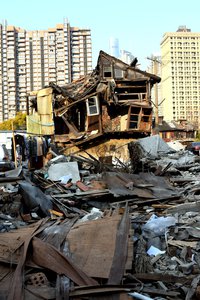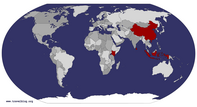Advertisement
Published: January 10th 2015

 One of the last
One of the last
A nail house near XiaonanmenThere’s an eerie pale light that swallows up East Asia on winter afternoons. I remember it from Korea, a yellow glow that elongated the bare trees and apartment blocks. It’s here in China too, casting long shadows across the rubble of a construction zone near Xintiandi. I’ve gotten bolder about walking into construction zones lately. Shanghai is in a perpetual state of being torn apart, demolished, renovated, and rebuilt. Sometimes the process seems to happen overnight; a new building springs up, a new restaurant, a new shop. At other times it seems to be a slow progression as soon-to-be displaced residents cling to their dwellings.
These homes, standing alone in a sea of debris, are often

 Having a smoke
Having a smoke
A half-demolished neighborhood near Xintiandireferred to as nail houses. Even before I returned to China I’d seen many photos circulated in the news. As casualties of the new construction boom these hangers-on lived in the midst of freeways, shopping centers, and towering skyscrapers . In the nearly two years I’ve lived in Shanghai, I’ve seen numerous neighborhoods transformed and swept away. I used to timidly peer over walls and peek through cracks in fences, intrigued by rapid rebirth of the city.
Now I simply walk in, camera in hand. I don’t want to exploit anyone and I certainly don’t want to promote the struggles of the residents as means of amusement for a weekend tourist. But I think that it’s important to document Shanghai's seemingly constant changes. It is perpetually catapulted toward modernity, but also locked in the past. It seems to be a city still experiencing growing pains, uncertain of what it will become.
On this particular day just after the new year, C and I have wandered into a crumbling neighborhood on Fuxing Road. It's an old neighborhood in Xintiandi that first caught my eye last year. It’s slowly being dismantled, brick by brick. Most of
the buildings are only hollow shells; rubble spilling from the doors, exposed beams and wires hanging from the ceilings. By the looks of it there are still a few residents hanging on, though the scene was mostly deserted when we strolled through. There were just a few little boys playing on the mounds of debris and a worker taking a nap on his bicycle.
There was also some graffiti scrawled along the walls – one was a symbol I have come to recognize from my demolition tours. It’s a sort of amoeba; bold black lines like stained glass and shades of purple and white. I’ve seen in many similar neighborhoods and imagine it to be some sort of protest against the rampant destruction of the old neighborhoods. Here in Xintiandi it had been partially painted over.
Another slogan, spray-painted in Chinese characters read “This city is my oldest friend”. I wondered if they were talking about Shanghai in general, or their quickly-disintegrating neighborhood.
Just a few blocks away we emerged into a completely different side of Shanghai: shopping malls and Starbucks, Louis Vuitton, and luxury hotels.
Xinzha 
 Graffiti
Graffiti
Moganshan Rd.Every week, we offer some sort of event for the students. When possible, we try to do something related to American culture, like a Halloween party or Thanksgiving dinner. More often than not, however, these outings take us around Shanghai doing things like bowling, ice skating, or visiting a museum. Many of our students come from outside of Shanghai and are away from home for the first time. In a strange twist, we become the tour guides; helping them to buy metro tickets and shuffling them from one place to another.
Sometimes, we take them on the sightseeing bus. I feel a little guilty about this, imagining myself in the shoes of other passengers as 15 exuberant teenagers clamor onto the bus. But they have fun as the bus rattles down the narrow streets between People’s Square and the Bund, careening around corners, dodging flapping laundry and low-hanging branches. Then we reach the river and look across to Pudong with its sparkling skyscrapers. On one such occasion my coworker sighed wistfully. “This is half the reason I moved to Shanghai.”
I have to agree. Set on a bend in the river with

 Another Longtang
Another Longtang
walking between People's Square and Xinzhaits unique collection of buildings, the skyline is instantly recognizable. Its most glaring standouts are The World Financial Center (perfectly resembling its nickname “the Bottle Opener”), the sparkling JinMao Tower, the Pearl Tower (which looks as though it’s ready to blast off into space) and the still-under-construction Shanghai Center that will soon be the second tallest building in the world. At night the scene becomes even more postcard-worthy as flashing neon characters scrawl across the buildings.
As spectacular as that view of Shanghai is, the city is also so much more.
Shanghai’s early glory days came in the 1920s and 30s, prior to the Second World War. Recognized as a major trading port, it was divided up by Western powers after the Opium War. The French Concession became a mini-Paris, with rambling mansions, wide, tree-lined boulevards, and outdoor cafes. The British and American settlements lay on the outskirts, near today’s Suzhou Creek. They all built their trading houses next to the bustling port, which is today the Bund. Shanghai became a truly international city, with its foreign population not only made up of Western Europeans, but also those from Russia, Japan, Korea, and elsewhere
in Asia.
In her book Shanghai author Harriet Sergeant travels to the city in the early 1990s to conduct research an interview survivors about the city’s vibrant past. She confronts a conundrum, however, finding Shanghai’s once vivacious neighborhoods run-down and somber. "To write about a spiritually dead city presents difficulties." She lamented in the introduction of her book. Similarly, in his 1989 travel epic Riding the Iron Rooster, Paul Theroux describes Shanghai as haunted, empty, drab, and full of ghosts.
Indeed, after the boom of the 1930s the city entered into a period of darkness, characterized by Japanese bombings, poverty, and the destruction of the Cultural Revolution.
But since the visits of Theroux and Sergeant, Shanghai has rebounded. Now, with China destined to be the number one economy in the world, the city is back - bolder and brighter than ever before. This prosperity is evident in the shimmering Pudong skyline and in the foreign community that is again thriving. It is a cosmopolitan city once more, with world-class restaurants, innovative museums, and an impressive line-up of performing arts. Glimpses of old Shanghai are possible as well: in the lanes of
the French Concession, the Temple of the Town God, the traditional markets, and the narrow alleys around People’s Square, Xionanmen, and Suzhou Creek.
Balancing the old and new, however, is proving to be an extremely challenging task. It seems that the European sections of the city are generally valued and protected. Historical buildings in my neighborhood are well-marked and seemingly unthreatened by large-scale building projects (though I have been told that there is little monitoring of renovations made by private owners…such was the fate of JG Ballard’s old house). Some are homes, while others have been converted to shops, hotels, and restaurants.
One victim of of Shanghai's ambitious urban expansion are the traditional Shikumen and Longtangs. Shikumen means “stone gate” and refers to a type of town house. Generally they are two or three stories and made of stone or brick. The houses are connected to their neighbors and set along a “longtang”, or alley. They began as housing for migrant workers in Shanghai in the late 1800s, but by the 1920s many were being upgraded to more comfortable, permanent living quarters. The longtang formed a community for its residents. Children played outside of
their houses, old men met for games of mahjong, and women cooked in the kitchens, which were often located outdoors.
It is still possible to see these communities today, though they are dwindling. Time Out Shanghai has an excellent walk (http://www.timeoutshanghai.com/features/Around_Town-Around_Town/6462/Shanghai-walks-Peoples-Square-longtangs.html) that takes you into a narrow alley near Nanjing Road and leads you through a series of longtangs until you reach Xinzha. Similarly, many of the neighborhoods around Suzhou Creek, Yu Garden, and Xintiandi have Shikumen, in various levels of preservation and destruction.
Some have been beautifully renovated; others are one the verge of demolition. My favorite is not far from Suzhou Creek. Its counterpart has already been replaced by a construction site and the alleys were nearly empty, an eerie feeling in bustling Shanghai. I caught a glimpse of one of the Shikumen through a rotating gate – its elegant stone archway covered in moss. It was like wandering around the set of an old movie. An elderly woman was washing her clothes in one of the stone sinks and another lady was feeding a flock of chickens near the entrance. Some of the houses still had strings of firecrackers hanging from

 old house
old house
the other side of Xintianditheir dusty windows. Some had chalk drawings on their abandoned walls.
“It really is a shame,” I lamented to Craig. “Why can’t they just keep them? Fix them up?”
We tried to think of reasons. Maybe the houses were too old to be salvaged, maybe they could no longer support the quality of life desired by most residents. After all, the kitchens were tiny and dark, some were without private bathrooms, others looked dank and poorly insulated. It would take a lot of work and money to modernize them. I'm sure that while some tenants lament the loss of their homes, there are others who welcome the change to move to a larger, better equipped residence. Still, its evident that with the urgency to build and transform parts of the city, those who stand in the way have few options.
I truthfully don’t know that Shanghai will look like in ten or twenty years. Often, I feel like it changes from week to week. Businesses come and go. It’s common that we will head out to a favorite restaurant or coffee shop only to find that it has closed/moved/ is being
renovated/burned down. The only thing I can say with certainty is that I am happy to be here now, to see this place in its most recent incarnation…and take lots of pictures.
Advertisement
Tot: 0.131s; Tpl: 0.015s; cc: 8; qc: 24; dbt: 0.0888s; 1; m:domysql w:travelblog (10.17.0.13); sld: 1;
; mem: 1.1mb
























